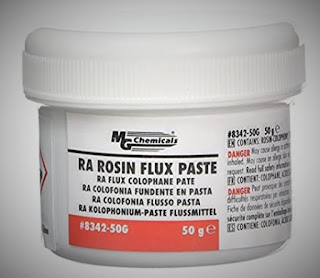Test tinning of a 12awg silicone covered wire tip melted the rosin-core solder right through the thick wire (turning it over once). I used an old wide tip 100w soldering iron, it worked better than the soldering pot I wasted $30 on, that should have gone towards an adjustable heat iron. Now I need to find a set of tips that fit the iron. Or at least get acid core flux and steel wool to clean the old tip with.
A large soldering gun [at least 200-260 watts] is recommended in the videos. Yet a well tinned chisel tip [6-9mm {¼” to ⅜”} wide] works better at 100w than a soldering gun that uses more wattage. But it really does need a temperature controller. A Weller iron with controller can't be much more expensive than a soldering gun.
Round tips are not good at transferring heat.
You could use a high wattage soldering iron like the Hakko [up to 900w] but they require more amperage than the wires to my house will handle. And I expect that the XT-90 connectors with capacitors in them would be destroyed. The smallest solder pot uses only 100w. The 45 amp Anderson connectors would be good enough for low voltage use [52v] but a high powered bike may draw more amps from your battery.
Soldering irons have improved drastically since the last time I bought one; this one has a digital controller in the handle and ceramic heating element. A wide chisel tip 3/8th inch wide [4.8mm] works well for tinning the ends of 10awg silicone covered wire with hundreds of tiny strands, at 896°f [480°c] if you use plenty of rosin flux paste. A 3/8th wide tip can work faster because of the larger mass to transfer. Wattage does not actually mater much unless trying to solder a copper pipe, then you should be using a Butane torch.
And remember that the only thing that acidic plumbers flux is good for is cleaning soldering iron tips.
When searching for connectors always use the right size wire gauges. 18awg is the smallest you should use, and the phase wires must be at least 12awg. While the battery wires 8 to 10awg unless building a smallish battery pack. The Hall sensor wires could be 20awg, but 18 is ok because the small the number the thicker the wire is.
 |
| 7 pin aircraft connector |
 |
| https://www.amazon.com/dp/B073VLQTRF/ ref=pd_luc_rh_sspa_dk_huc_pt_expsub_2?psc=1 |
 |
| Anderson Connectors |
- Assortment of JST connectors [2, 3, 4 and 7 pin....]
- Water proof connectors???? [only if they are exposed to water.]
- Large and Small soldering irons [or one with variable temperature]
- Solder small [watch videos]
- Paste flux for copper
- XT150 Bullet connectors [phase wires]
- XT90 connectors [power wires]
- Handle bar switches
- Shrink tube [different sizes and colors]
- 10awg silicone covered wire [red and black]
- 12awg silicone covered wire [green, yelow, blue] phase wire extention!
- 18awg wire [verius collors] Hall sensor extention etc.
- Brake levers with cut-off switches [Essential!!!]
- ¾ inch split tube for wire extentions.
- Friction tape [rain proofing exposed connectors and soldered wires]
- Liquid tape [black, for final rain proofing]
- Electrical anti-oxidant grease compound [for better connections]
- Varius flashing LED side lights [visability on dark days]
- Head lights with shaped beams [to keep from blinding car drivers]
- Seperate battery pack for lights.
- Tranquelizers [the smokin kind]
 |
Split Loom wire organizer |
DIY Garage; Connectors for Halls, Throttle, and Motor
Water-proofing, and basic ebike trouble-shooting
Choosing Solder Types
Mt. Goat Cycletruck Gearing








No comments:
Post a Comment